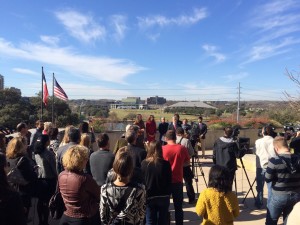
Photo credit: Aaron Majors
We didn’t need another study to tell us that Austin’s local music industry is suffering under the affordability crisis, but the news that it has lost 1,200 jobs since 2010 was sobering. We won’t be the Live Music Capital of the World for much longer if we keep losing musicians and music venues.
We’re going to need all our creativity, ingenuity, and vision to deal with the crisis that faces the musicians and artists alike who are getting priced out of homes and studio space. The work they are producing is as vibrant as ever, but this city has never been more unaffordable for them. And what do we ultimately gain if we get another weekend of the ACL Festival but we lose another Liberty Lunch?
That’s why today I am introducing the Austin Music and Creative Ecosystem Omnibus Resolution. This resolution proposes creative solutions for our creative class. Because inherent in these problems are opportunities identified in this resolution that, if successful, will help our local music and arts sectors thrive.
This town is very good at producing studies. This is NOT ANOTHER STUDY. The ideas in this resolution are the result of listening to people in the local music and arts sectors, and this resolution directs the City Manager to come back to the Council in 90 days with a prioritized action plan.
Growing an enhancing Austin’s music sector is the first step to supporting the creative ecosystem.
We’re going to identify best practices from leading music cities such as Los Angeles and Nashville that have vertical music industries. We need to figure out what the “Austin version” of a vertical music industry is.
We can also take a look at preserving music venues with land trusts, streamlining the permitting process with entertainment licenses, and codifying entertainment districts. And we should also take a look at letting Code Enforcement police the sound levels at music venues and freeing up the Austin Music Office to help the local music industry with economic development.
As I alluded to earlier, the affordability crisis is hitting the creative ecosystem hard, so we need to strengthen the artist and musician safety net. We can do this by matching existing services to unmet needs in the creative community such as housing and healthcare.
We also need to look at targeting our education resources to help musicians and artists to expand skillsets so they can expand their careers.
Another way the affordability crisis impacts the creative ecosphere is by making workspace too expensive. We must meet the pressing need for affordable creative arts spaces and housing.
This resolution envisions many ways the city can create hubs to catalyze creativity, including:
Inventorying creative facilities inventory to catalogue needs.
Adjusting the city code to allow studios on the 1st and 2nd floors of buildings.
And possibly expanding the Business Retention & Enhancement Program to include creative spaces.
A good example of such a hub is the Mosaic Sound Collective, an affordable and sustainable model for the Austin music industry. This will be a creative hub for musicians and artists with a focus on collaboration with existing music businesses and non-profits instead of competition. The space will be a one-stop-shop community of resources and services and will work directly with our Spirit of East Austin initiative. It could also be a model for what this resolution could achieve.
Great cities do big things, but not because they are great. They are great because they do big things. The Live Music Capital of the World should be a city where the local music industry thrives and expands and a city where artists and musicians can afford to live and create. That would indeed a big thing.
